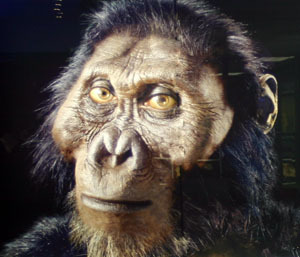New exhibition coming to Maropeng (Dec 6, 2008 - Mar 6, 2009)
Come and see for yourself what makes Paranthropus so special. From December 6 2008 until March 6 2009, Maropeng presents original Paranthropus fossils from various sites in the Cradle of Humankind, and others of Homo and other species of animals that lived at the same time in a fascinating new exhibition entitled Paranthropus in Context.

An artist’s impression of what Paranthropus would have looked like
Thanks to generous loans from the Transvaal Museum part of the Northern Flagship Institution and the Bernard Price Institute, University of the Witwatersrand, the general public will be able to view these magnificent fossil specimens up close. These fossils only very rarely go on display – some have only been displayed a few times since their discovery.
The exhibition is to be housed in Maropeng’s Original Fossil Display. The highlights include:
- Fossils of both Paranthropus and early Homo – what scientists believe to be our direct ancestors – which coexisted in the Cradle of Humankind about 2-million years ago.
- Bone tools that either or both of these species may have made
- The original burnt bone material that proved that the first evidence of controlled use of fire in Southern Africa was at Swartkrans, in the Cradle of Humankind. Yes, we in Gauteng have been braaiing for more than 1-million years! Scientists generally accept that it was Homo, not Paranthropus, that was controlling this fire.
The debate:
Paranthropus is at the centre of some major scientific debate at the moment. At Swartkrans, in the Cradle of Humankind, there is fossil evidence of Paranthropus robustus as well as Homo ergaster, which have been found along with fossils of baboons, leopards, sabre-toothed cats, hyenas and antelope.
Scientists have traditionally thought that Paranthropus was not capable of tool-making, and that only hominids belonging to the Homo genus, were toolmakers. Now, this assumption is being challenged. University of the Witwatersrand palaeontologist Dr Lucinda Blackwell suggests that Paranthropus may have made these. Others have said the sharpened bone tools are simply the work of porcupines. Who made the tools? Was another genus capable of such advanced thought?
Blackwell’s research suggests that indeed, Paranthropus was using bone tools to extract termites, a rich source of protein, and the fact that they might have been making the bone tools does not reflect a species that is as inferior as previously thought. These questions and more will be looked at the display. And you are able to see REAL hominid fossils which in most instances are kept locked away from the public eye. This is a once in a lifetime opportunity don’t miss it.
The price of admission is included in the normal ticket cost for Maropeng.
How the first Paranthropus was discovered
In 1938, a schoolboy, Gert Terblanche, discovered a partial skull of a fossil hominid with uncharacteristic features at Kromdraai, in the Cradle of Humankind. He handed the primitive palate and a molar tooth to Sterkfontein’s quarry manager, George Barlow, who regularly gave palaeontologist Dr Robert Broom of the Transvaal Museum specimens to examine. When the famous palaeontologist saw the fossil, he immediately set out to find Terblanche.
“I naturally went to the school, and found the boy with four of what are perhaps the most valuable teeth in the world in his trouser pocket,” Broom later said.
Terblanche led Broom to the Kromdraai site, where together they found part of the skull and jaw of the same specimen. This discovery led Broom to declare the fossils were evidence of a new hominid genus and species, Paranthropus robustus. Paranthropus had prominent cheekbones, a massive jaw and large teeth.
Later discoveries of Paranthropus at Swartkrans in the Cradle of Humankind and in East Africa showed the males had a bone ridge or “sagittal crest” on the top of their heads to which powerful muscles were attached.
These heavy-chewing adaptations led Broom and his colleague, John Robinson, to affirm that this hominid was in a separate genus to Australopithecus, which many palaeoanthropologists think is a more direct ancestor of modern humans.
The discovery of the first Paranthropus robustus at Kromdraai in 1938 helped change the way anthropologists saw the evolution of humankind.
More about Paranthropus
The flat-faced Paranthropus existed in South and East Africa from about 2.5-million to 1-million years ago. Its large jaws and teeth were adapted to grinding tough food such as roots, hard seeds and berries.
An offshoot of the lineage leading to humanity, it was not a direct ancestor, but more like a distant cousin. With the discovery of Paranthropus, scientists realised that the evolutionary path to modern humankind was not a simple sequence in which one set of human ancestors evolved over time, in a neat chain of progression. It is a complicated – and still contested – family tree, with many branches breaking off as species of ancestral relatives became extinct.